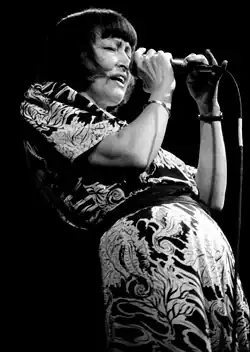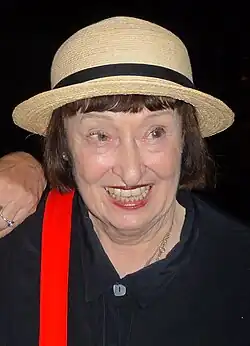Sheila Jordan
Sheila Jordan | |
|---|---|
 Jordan in 2011 | |
| Background information | |
| Birth name | Sheila Jeanette Dawson |
| Born | November 18, 1928 Detroit, Michigan, U.S. |
| Died | August 11, 2025 (aged 96) New York City, U.S. |
| Genres | |
| Occupation |
|
| Instruments |
|
| Labels | |
| Spouse | |
| Website | www |
Sheila Jeannette Jordan (née Dawson; November 18, 1928 – August 11, 2025) was an American jazz singer and songwriter. She recorded as a session musician with an array of critically acclaimed artists in addition to recording her own albums. Jordan pioneered a bebop and scat jazz singing style, with an upright bass as the only accompaniment.[1] Jordan's music has earned praise from many critics, particularly for her ability to improvise lyrics; Scott Yanow described her as "one of the most consistently creative of all jazz singers".[2] Charlie Parker often introduced Jordan as "the lady with the million dollar ears".[1][3][4]
Life and career
Early career
Sheila Jeanette Dawson was born in Detroit, on November 18, 1928.[5][6][7] Her father left soon after her birth and remarried. (She later met her half-siblings.) Her mother struggled with alcoholism.[6] She was soon sent to live with her maternal grandparents in Summerhill, Pennsylvania, a small coal mining town in the Allegheny Mountains.[6] Her grandparents raised her with little warmth or affection, and her grandfather also struggled with alcoholism. She recalled their hardship and poverty:[6][8]
We were probably the poorest people in a poor town [...]. [... W]e had an outhouse and no water in the house [...]. In the wintertime [we'd] sleep in one bedroom without any sheets or pillowcases on the beds; we just had blankets.
Jordan returned to live with her mother in Detroit by 1942,[6][7][8] performing as a jazz club singer and pianist.[7] She helped write lyrics to Charlie Parker's music in the trio Skeeter, Mitch, and Jean (Skeeter Spight, Leroi Mitchell, and Sheila "Jean").[7] They met Parker at his Detroit performances, and he invited them to sing.[9]
Jordan moved to New York City in 1951, studying music theory with Lennie Tristano and Charles Mingus.[7] She focused on the music of Parker, whom she befriended and considered a teacher,[10] later recalling: "I guess I was chasin' the Bird [Parker]."[11] Asked if the song "Chasin' the Bird" was written for her, she said: "No. I don't know how that rumor got started."[11] In 1952, she married a Parker bandmate, pianist Duke Jordan.[5][12][8]
Later career (1960–2025)
In the early 1960s, she performed at the Page Three Club in Greenwich Village with pianist Herbie Nichols[13] and at other New York venues. Duke Jordan's heroin addiction contributed to their 1962 divorce, but they had a daughter, Tracey, whom she "could truly love" and was "sure would love me back".[8] Jordan partly withdrew from clubs in the 1960s to raise Tracey, and sang in church instead. She worked as a typist and legal secretary for 20 years, with less time for music until she was aged 58.[14][5] In 1962, she recorded "You Are My Sunshine" with George Russell on his album The Outer View (Riverside)[15] and also recorded her debut album Portrait of Sheila, released on Blue Note in 1963.[1] She began a long collaboration with Steve Kuhn in the early 1960s[16] and played with Don Heckman (1967–68), Lee Konitz (1972), and Roswell Rudd (1972–75).[12]
In 1974, Jordan was Artist-in-Residence at the City College of New York, and taught there from 1978 to 2005. She received the Manhattan Association of Cabarets & Clubs (MAC) Lifetime Achievement Award in 2006, while celebrating 28 years as an adjunct professor of music.[17] She also taught at the University of Massachusetts at Amherst and the Vermont Jazz Center, Interplay Jazz and Arts, as well as teaching international workshops.[12][18]

On July 12, 1975, she recorded Confirmation.[7] One year later she released the duet album Sheila, with Arild Andersen for SteepleChase. In 1979, she founded a quartet with Steve Kuhn, Harvie S, and Bob Moses. During the 1980s, she worked with Harvie S as a duo and played on several records with him. Until 1987 she worked in an advertising agency and recorded Lost and Found in 1989.[7]
Jordan was a songwriter who worked in bebop and free jazz. In addition to the aforementioned musicians, she recorded with the George Gruntz Concert Jazz Band,[19] Cameron Brown,[20] Carla Bley,[21] and Steve Swallow.[22] Jordan led recordings for Blue Note, East Wind, ECM, Grapevine, Muse, Palo Alto, and SteepleChase.[23]

In 2012, she received the NEA Jazz Masters Award.[24] Her biography, Jazz Child: A Portrait of Sheila Jordan, written by vocalist and educator Ellen Johnson, was published in 2014. Jordan describes her own struggles with addiction in the book.[25]
Jordan died at her apartment in New York City, on August 11, 2025, at the age of 96.[26]
Awards and honors
- 2006: Manhattan Association of Cabarets & Clubs Lifetime Achievement Award[27][28]
- 2007: International Association for Jazz Education Humanitarian Award[27][29]
- 2008: Mary Lou Williams Award for Lifetime of Service to Jazz[30]
- 2010: New York Nightlife Award – Outstanding Jazz Vocalist[27]
- 2012: National Endowment for the Arts Jazz Master Award – Lifetime Honors Award[27]
- 2018: Bistro Award Outstanding Contributions to the Art of Jazz[27]
Discography
As leader
- Looking out (1961)[23]
- Portrait of Sheila (Blue Note, 1963) – recorded in 1962[5][23][31]
- Confirmation (East Wind, 1975)[5][23][31]
- Sheila, with Johnny Knapp (Grapevine, 1977)[23][31]
- Sheila, with Arild Andersen (SteepleChase, 1978) – recorded in 1977[31]
- Playground with Steve Kuhn (ECM, 1980) – recorded in 1979[5][23][22]
- Last Year's Waltz (ECM, 1981)[23]
- Old Time Feeling, with Harvie S (Palo Alto, 1983) – recorded in 1982[23][22]
- The Crossing (BlackHawk, 1984)[5][23]
- Songs from Within, with Harvie Swartz (MA, 1989)[23][32]
- Lost and Found (Muse, 1989)[23][22]
- One for Junior, with Mark Murphy (Muse, 1991)[23]
- Heart Strings (Muse, 1993)[23]
- Jazz Child, with Steve Kuhn (HighNote, 1999)[23][31]
- Sheila's Back in Town (Splasc(h), 1999)[23]
- The Very Thought of Two, with Harvie Swartz (MA, 2000)[23][32]
- Little Song, with Steve Kuhn (HighNote, 2003)[5][23]
- Celebration, with Cameron Brown (HighNote, 2005)[23][22]
- Winter Sunshine (Justin Time, 2008)[23]
- Yesterdays (HighNote, 2012), recorded in 1990[5][23]
- Live At Mezzrow (Cellar Live, 2022) – live recorded in 2021[5][23]
- Comes Love: Lost Session 1960 (Capri Records, 2021)[5]
- trioTrio Meets Sheila Jordan (SteepleChase, 2022)[5][23]
- Portrait Now (Dot Time Records, 2025)[23]
As featured vocalist
With Carla Bley
- Escalator over the Hill (JCOA, 1971)[21]
With Cameron Brown
With George Gruntz
With Bob Moses
With Roswell Rudd
- Flexible Flyer (Arista/Freedom 1974)[34]
- Blown Bone (Philips, 1979)[35]
- Broad Strokes (Knitting Factory, 2000)[36]
With Steve Swallow
Academia
Former students
- Laura Valle[37]
References
- ^ a b c Latimer, Charles L. "Bebop and Beyond: Sheila Jordan Speaks". Detroit Music History. Archived from the original on March 4, 2016. Retrieved August 3, 2013.
- ^ Yanow, Scott. "Sheila Jordan". Artist Biography. AllMusic. Retrieved August 3, 2013.
One of the most consistently creative of all jazz singers, Sheila Jordan has a relatively small voice, but has done the maximum with her instrument.
- ^ "Saturday, March 21st: 10:30 – Focus on Women in Music". KPFA Folio. March 1981. p. 26. Retrieved May 10, 2022.
- ^ "Lulu: Last 2 Nights! Sept. 20 & 21, Sheila Jordan & Steve Kuhn: '... million dollar ears!'". The Boston Phoenix. September 23, 1980. Retrieved May 10, 2022.
- ^ a b c d e f g h i j k l m Lea, Nick; Mancio, Georgia (July 2022), "Sheila Jordan: Portrait of a Legend". Women in Jazz Media Magazine, p. 100. Retrieved August 14, 2025.
- ^ a b c d e Singer, Barry (August 12, 2025). "Sheila Jordan, Fearless Vocal Improviser, Is Dead at 96". The New York Times. Retrieved August 12, 2025.
- ^ a b c d e f g Larkin, Colin, ed. (1992). The Guinness Encyclopedia of Popular Music (First ed.). Guinness Publishing. pp. 1324/5. ISBN 0-85112-939-0.
- ^ a b c d Lea, Nick (November 18, 2022). "Sheila Jordan – Portrait of a Legend". Jazz Views.
- ^ Vitro, Roseanna (November 29, 2012). "Sheila Jordan: Vocal Shaman". JazzTimes. Retrieved August 3, 2013.
- ^ "Billy Taylor's Jazz at the Kennedy Center". Sheila Jordan. National Public Radio. Retrieved August 3, 2013.
- ^ a b Myers, Marc (January 5, 2012). "Interview: Sheila Jordan (Part 2)". JazzWax. Retrieved August 3, 2013.
- ^ a b c "Lifetime Honors". Biography. National Endowment for the Arts. 2012. Retrieved August 3, 2013.
- ^ Spellman, A. B. (1985). Four Lives in the Bebop Business (1st Limelight ed.). New York: Limelight Editions. p. 156. ISBN 0-87910-042-7.
- ^ Dagan, Ori (January 28, 2009). "Joy and Justice: the Jazz Journey of Sheila Jordan". TheWholeNote. Retrieved August 3, 2013.
- ^ Witherden, Barry (May 1987). "A Singer in the Mirror". The Wire. p. 16.
- ^ Reney, Tom (April 27, 2012). "Sheila Jordan and Steve Kuhn". New England Public Radio. Archived from the original on August 6, 2012. Retrieved August 3, 2013.
- ^ "Jazz Great & Ccny Music Professor Sheila Jordan Wins MAC Lifetime Achievement Award" (Press release). Tribeca Performing Arts Center: The City College of New York. April 10, 2006. Archived from the original on May 13, 2006. Retrieved August 3, 2013.
- ^ Feather, Leonard (February 23, 1989). "Sheila Jordan's Slow Rise to Recognition". Los Angeles Times. Retrieved August 3, 2013.
- ^ a b Theatre AllMusic 2025
- ^ a b Shoemaker, Bill (May 13, 2024). "Cameron Brown and the Hear and Now: Here and How!". Jazz Times.
- ^ a b "Jazz Composers Orchestra: Escalator Over The Hill". Jazz Discography. 2025.
- ^ a b c d e f g Sheila Jordan, Dot Time. 2025.
- ^ a b c d e f g h i j k l m n o p q r s t u v w x "Sheila Jordan", AllMusic, 2025.
- ^ "Lifetime Honors". National Endowment for the Arts Jazz Masters. National Endowment for the Arts. 2012. Archived from the original on July 4, 2010. Retrieved August 2, 2013.
- ^ Johnson, Ellen (September 2014). Jazz Child: A Portrait of Sheila Jordan. Rowman and Littlefield. ISBN 9780810888364.
- ^ Ulaby, Neda; Mayer, Petra (August 11, 2025). "Sheila Jordan, a singular voice in jazz, has died". VPM. Retrieved August 12, 2025.
- ^ a b c d e "Giving Tuesday with Sheila Jordan!" Vermont Jazz Center. 2025.
- ^ 2006. MAC awards 2025.
- ^ IAJE News: IAJE Humanitarian Award – Sheila Jordan mbrl.ae 2007
- ^ Pulliam, Becca (August 13, 2009). "Jazz Vocalist Sheila Jordan Honored In Concert". Retrieved August 17, 2025.
- ^ a b c d e Yanow, Scott (2025). "Sheila Jordan". Blue Note.
- ^ a b Sheila Jordan Mare Records 2025
- ^ "When Elephants Dream of Music", AllMusic. 2025.
- ^ Shoemaker, Bill (April 25, 2019). "Roswell Rudd: Flexible Flyer". Jazz Times.
- ^ "Roswell Rudd — Blown Bone (with Steve Lacy - Sheila Jordan)". Jazz Music Archives, 1979.
- ^ "Roswell Russ — Broad Strokes". Jazz Music Archives, 2000.
- ^ Vedasto, JP (August 31, 2020). "Perfection and Paralysis: Laura Valle on the Dichotomy of Performance". World Musician Press.